Pros and cons
Hanging railing in the kitchen is a simple matter, but first of all you need to weigh the pros and cons.
| pros | Minuses |
|---|---|
|
|
Kitchen location options
Roof rails can be placed in three ways:
- Horizontal. The classic look of the railing system when the pipe is mounted between the countertop and the upper kitchen cabinets. Hooks, baskets, shelves and other accessories are hung on it. To use the space as efficiently as possible, arrange the rails in the kitchen in several rows on an empty wall.
In the photo, an example of combining rails with shelves
- Vertical. The pipe is installed vertically from the countertop to the ceiling, and the shelves and baskets are attached to it at a distance from each other. Most often used for bar counters and peninsulas. But such a design no less perfectly fits into the free corner of the kitchen set.
In the photo roof rails for the kitchen in the interior with a bar
- Suspension. Based on the name, you guess that the railing system hangs from the ceiling. It looks most spectacular above the island - suitable for organizing the storage of pans and cutting boards. Or above the bar - for glasses, glasses and even bottles.
Hanging pan storage system
What can be hung on railing?
The chimney on the wall alone will not add functionality to your kitchen. Most importantly - mounted modules, which are selected depending on the personal preferences of each.
Consider the main suspension options:
Hook. The simplest and budget, while effective filling. On them you can hang various soup ladles, shovels, towels, potholders, pans, stewpan and much more.
Shelf. Depending on the size and depth, they store everything from detergents and sponges to cans with sauces and seasonings.
Basket. Thanks to its high edges, it is safer than a shelf and is more suitable for tall bottles and cans.
Glass. Not all kitchen utensils have openings and hooks, the presence of a glass will solve this problem - just make cutlery, spatulas and other things in it.
In the photo, an option for open storage of utensils
Dryer. They are used both for temporary arrangement of dishes after washing, and for permanent storage of the main set of plates and mugs.
Holder. Special designs are designed for:
- paper towels;
- foil, baking paper and film;
- pots and pans;
- lids; cookbooks and tablets;
- chopping boards;
- knives; mugs and glasses;
- small household appliances.
Magnet. Usually used to store knives, but you can place anything: iron jars for spices, flower pots and containers.
Bank. Suitable for horizontal railing system.Thanks to the lid in the form of a hook, it is placed directly on the tube without additional shelves. Because jars are small; spices are usually poured into them.
Pictured are wooden hanging holders
How to create a railing system for yourself?
When installing rails, the rule “more is better” does not work. Therefore, you should not buy all possible accessories for the railing system and try to find them to use.
It would be more correct to go from the opposite: observe your behavior during cooking and eating, as well as cleaning. What items and products do you use most often? Ideally, fasten on the railing what is used every 1-5 days.
To test the theory, make a model of the future design directly on the wall using masking tape. So you will understand if you have enough space and what is missing.
The photo shows a minimalist interior with a metal dryer
The package also depends on your kitchen:
- In small rooms, store on the railing only the most necessary, many items will create a sense of chaos.
- In a spacious kitchen, install a long pipe, placing the accessories at a distance from each other.
- In a headset with an angled sink, a dishwashing detergent and a sponge are removed on a hanging shelf.
- In the kitchen with a free surface in the corner there is a place for vertical railing.
Installation Features
Mounting the tube mount is similar to installing a cornice. But before you start it, you should decide on the location. Usually, railing is placed above the working area, sink or stove.
At what height do you hang rails?
Horizontal railing
The optimal height of the railing in the kitchen above the countertop is 45-50 cm. Most often it is mounted on an apron.
If you do not have upper cabinets, the railing can also hang above the apron - 60 cm from the working area. If there are cabinets - when marking, back away from them at least 10 cm down. At shorter distances, it will be inconvenient for you to remove the fasteners and use accessories.
Another important parameter is the load on the pipe. To prevent sagging, install the holders no more than 0.5 m apart. Not all manufacturers put enough parts in the kit, so additional supports will have to be purchased separately.
Vertical railing
Shelves and baskets with the most necessary should not be higher than the outstretched hands of the lowest member of the family. A place under the ceiling is used to place indoor flowers and decorative elements.
Hanging railing
Place it so that the hostess can reach the placed objects and take them without standing on the stool.
How to install railing in the kitchen: step by step instructions
Horizontal system installation
Based on your preferences, you can choose a solid long railing along the entire wall of the kitchen or short separate sections in the main areas of activity. Horizontal rails are placed not only on the wall or apron, they can be hidden in cabinets, attached to the end of the kitchen set or even on the door.
Before you begin installing roof rails in the kitchen, we will consider the system device. It includes the tube itself, a pair of plugs and holders. The latter serve as brackets. If you intend to install roof rails in the kitchen on 2 adjacent walls, you can purchase corner adapters - this way you will combine both parts into a single composition. A coupling is useful for connecting a long straight tube.
To fix the system on the wall you will need:
- level;
- roulette;
- pencil;
- screwdriver;
- hammer;
- dowels, self-tapping screws;
- hammer drill or hammer drill.
Getting started with the installation:
- Mark the location of the future railing with a tape measure, level and pencil.
- Mark the holes for the brackets with a maximum distance of 50 cm from each other.
- Drill holes, hammer in plastic expansion bolt shields in them.
- Insert the self-tapping screw into the sleeve (comes with a railing) and fix it in the wall.
- Put the holder on the sleeve, it is fixed with screws.
- Insert the tube into the holes in the holders so that the ends extend from both sides at the same distance.
- Secure the tube to the supports with screws.
- Install the plugs at the edges of the pipe.
See the video for more installation instructions:
Vertical installation
Vertical railing can be of 2 types: with and without struts. In the first case, the installation resembles the installation of a bar for the curtains in the bathroom - you don’t have to drill anything, just follow the instructions.
If there are no spacers, prepare the same tools as for the horizontal structure and proceed:
- Mark the holes for fastening on the lower (countertop or floor) and upper (ceiling) parts.
- Drill holes, hammer dowels into the floor and ceiling.
- Fasten the holders from the bottom and top using self-tapping screws.
Suspension Installation
The installation of the suspended railing is different from the first two, but you will need the same tools: tape measure and pencil, punch, wrench. The main difference in fasteners: the use of anchor bolts in the form of a hook. And on them on chains the system itself is suspended.
- Mark the holes for the anchor hooks.
- Drill in the right places along the diameter of the sleeve and clean it well from dust.
- Insert the hook into the hole and tighten with a key.
- Hang the chains on the hooks and the rails on them.
Photo in the interior
We have already said that the railing system is suitable for any style of interior, the main thing is to choose the right color and content.
The rails in the classic kitchen are most often platinum or gold. They hang beautiful potholders or towels, skimmers and ladles from the same set, put spices.
Flowers on roof rails in the kitchen in minimalistic flower pots will appeal to fans of the Scandinavian style. In a white kitchen, black roof rails, echoes with furniture handles, will look best.
Copper, brass and bronze will look great in a loft style. Keep pans, wooden cutting boards, and other interesting utensils on them.
If you like modern, hi-tech or minimalism, choose chrome models. On attachments, you should not save money - instead of simple round pipes, install stylish flat strips.
Pictured is a modern kitchen with unusual storage
And finally, some important tips on how to arrange roof rails for the kitchen:
- towels, a shelf with household chemicals, a dish dryer are hung near the sink;
- at the stove you will need oven mitts, cookers and shovels, spices, sauces and butter;
- in the food preparation area, cutting boards and knives are useful;
- above the bar, the holder for glasses and the wine shelf will look appropriate;
- for the convenience of using books with recipes, a special shelf with a clip is useful;
- a holder with a serrated edge will facilitate tearing foil, parchment paper and cling film;
- storing roof rails in the kitchen will relieve you of the problem of their inconvenient placement in the closet.
Photo gallery
Railing is just a system designed to simplify the cooking process. But its effectiveness depends primarily on how well you think through the internal content.

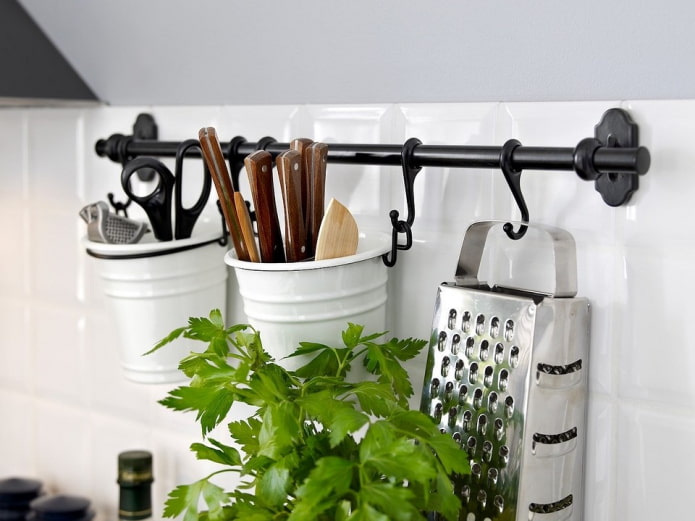
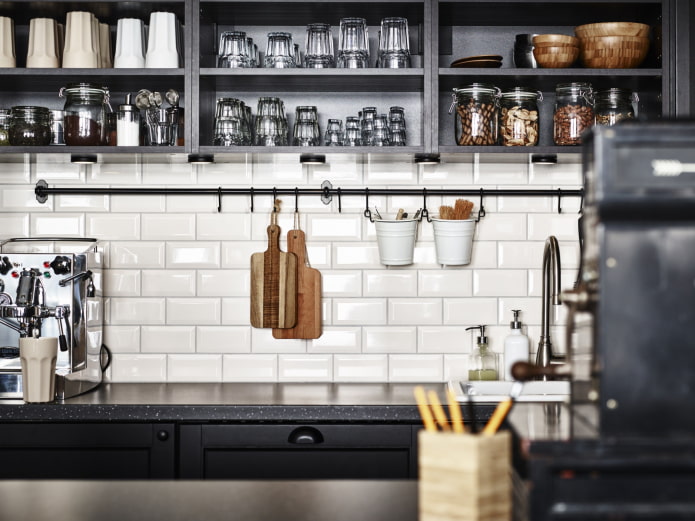
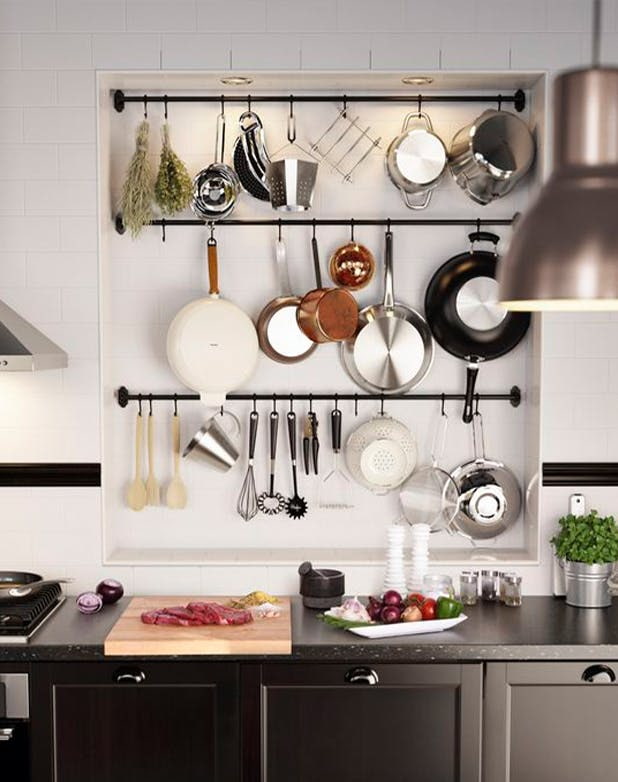
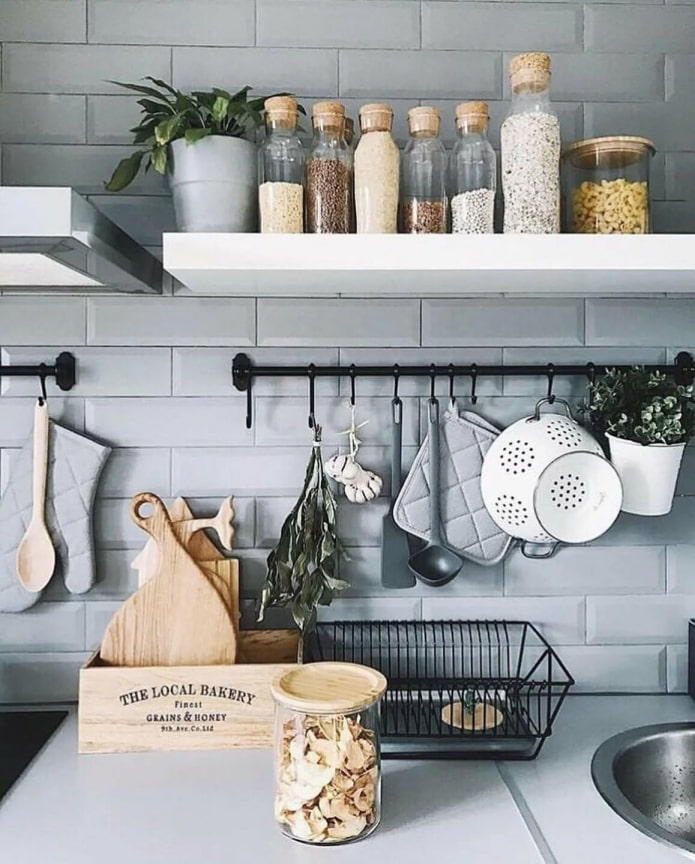
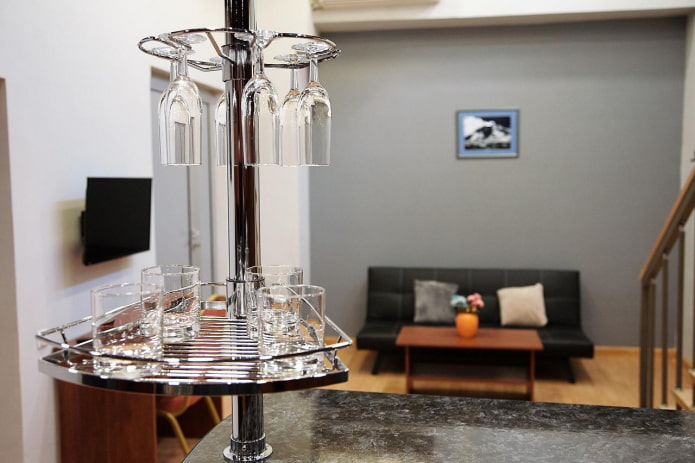
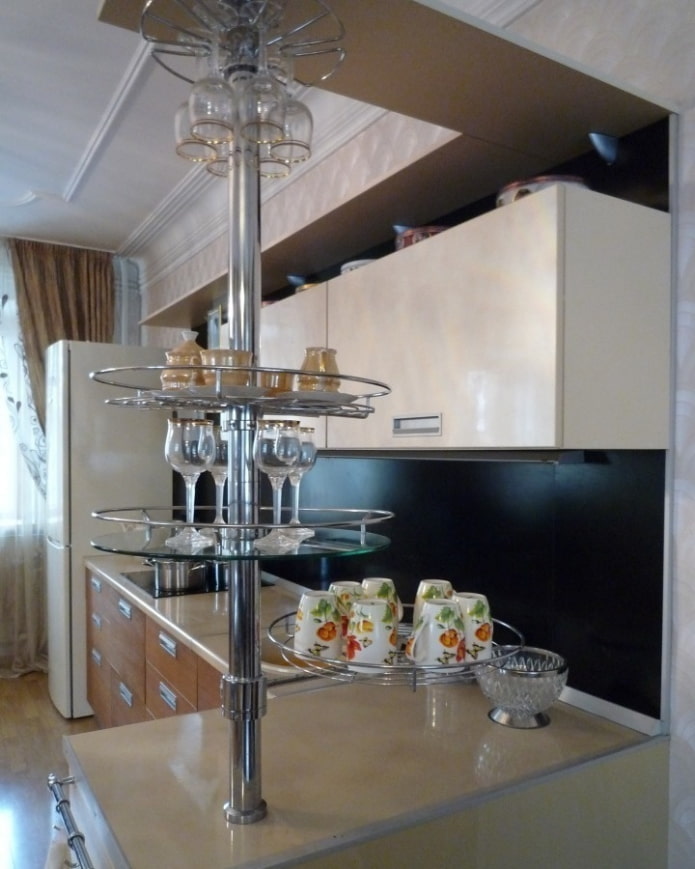
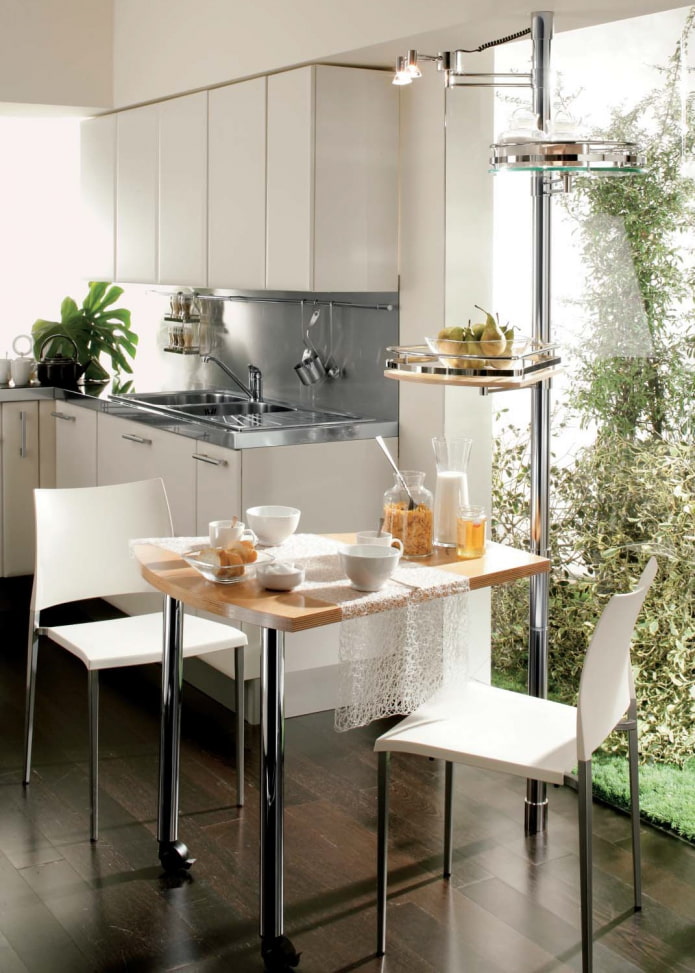
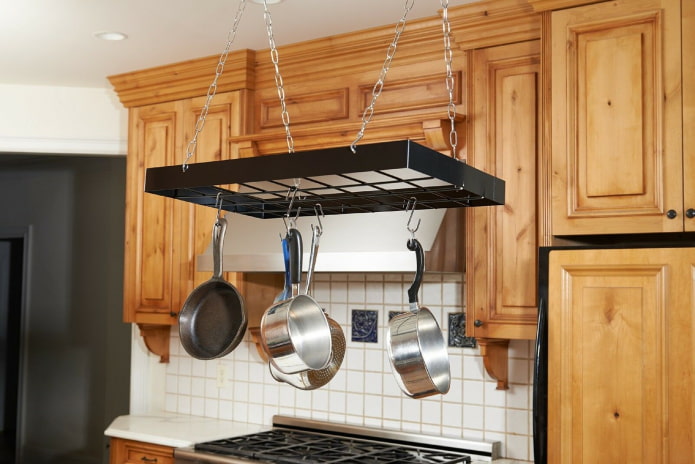

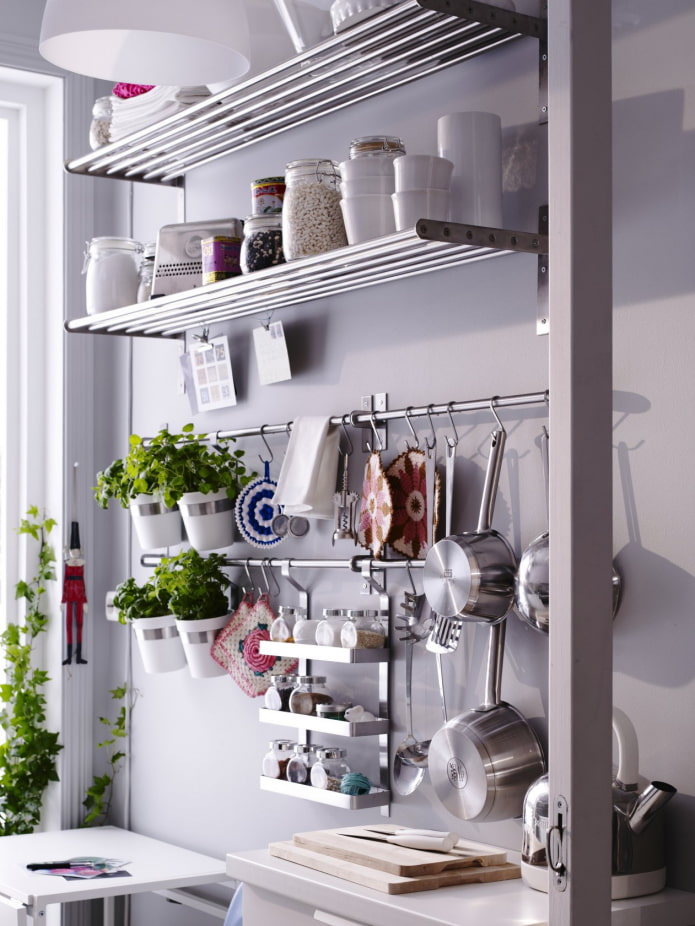
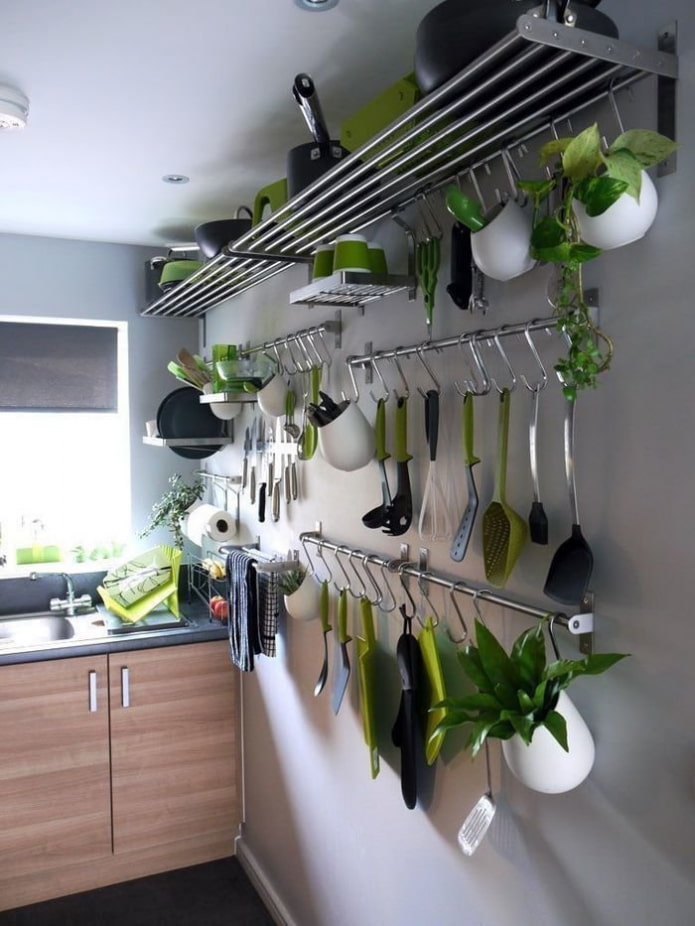

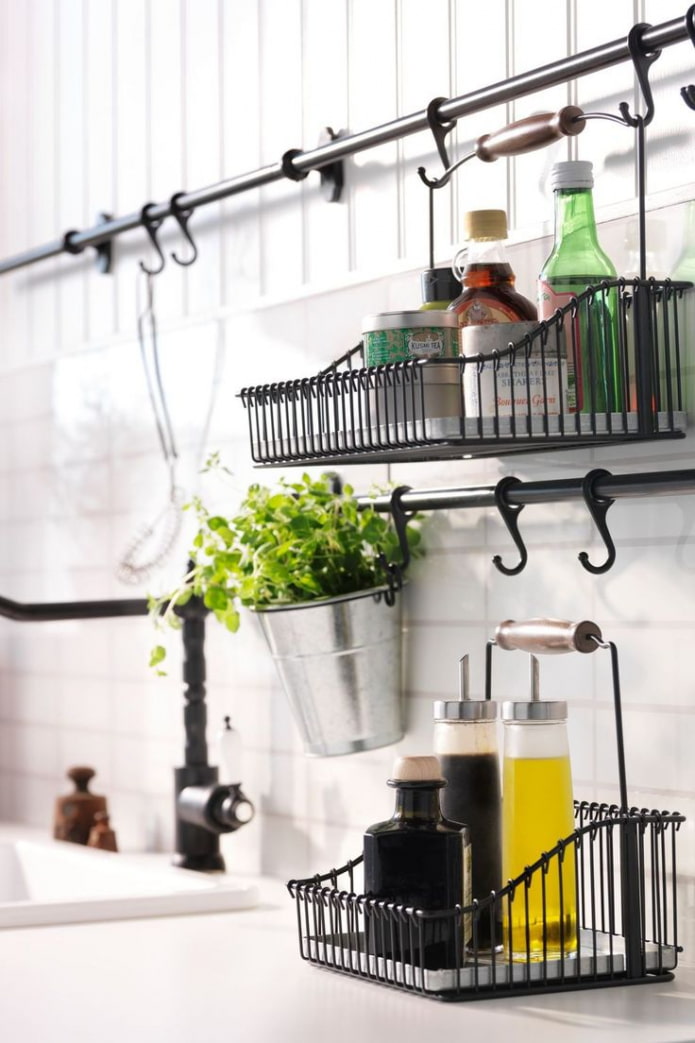

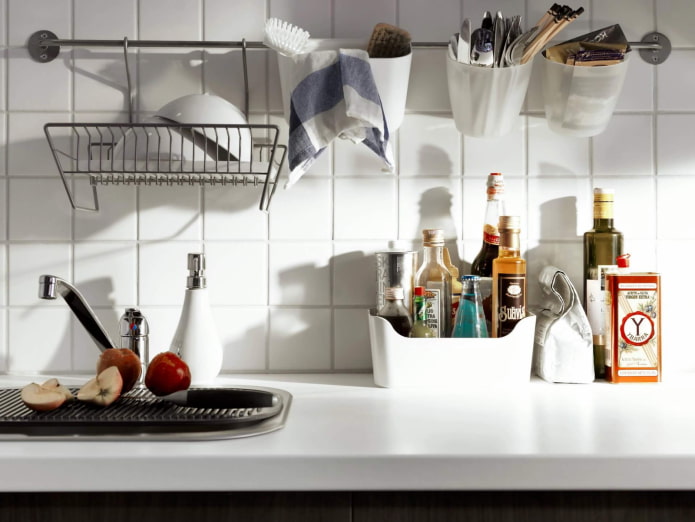
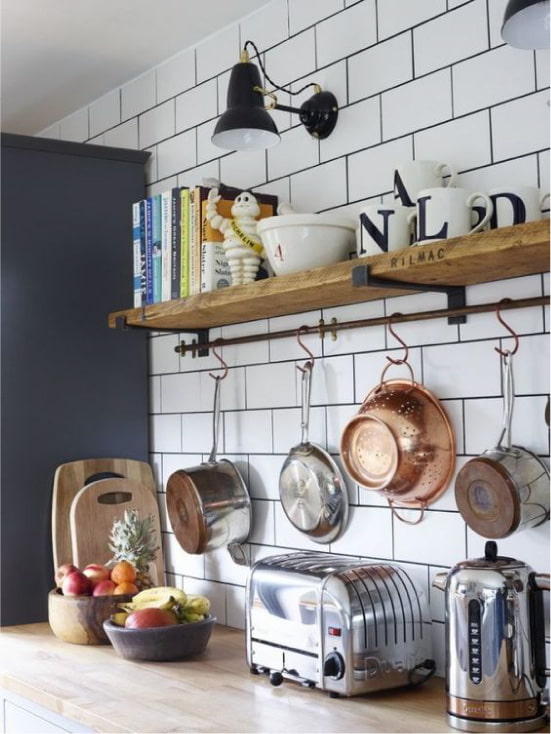
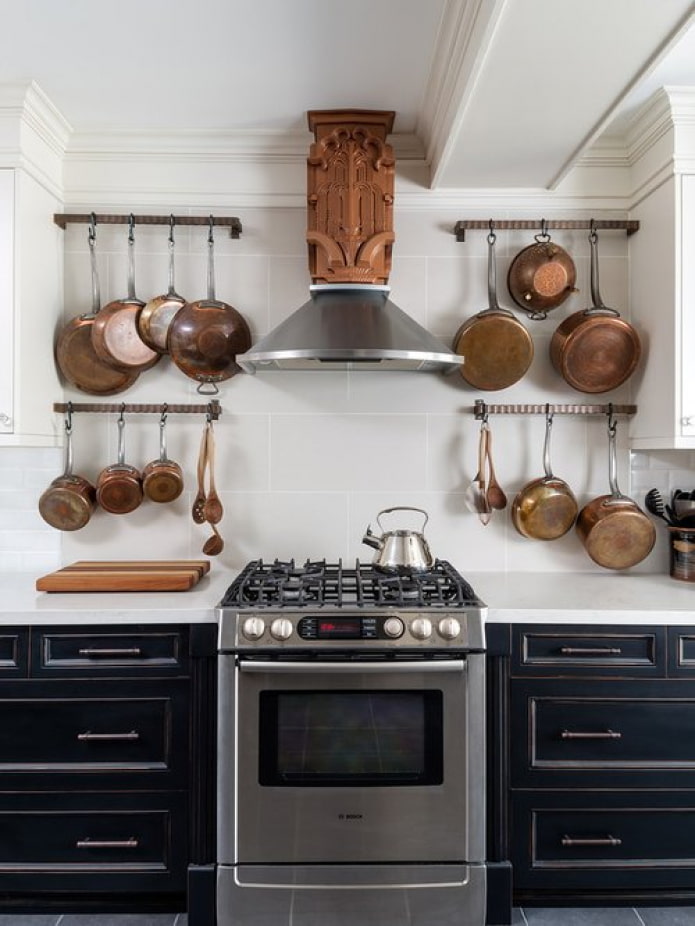
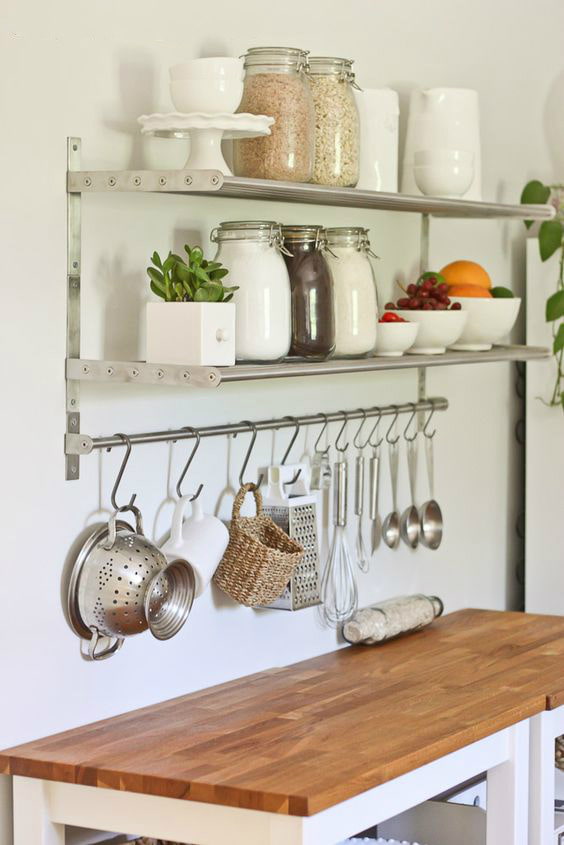
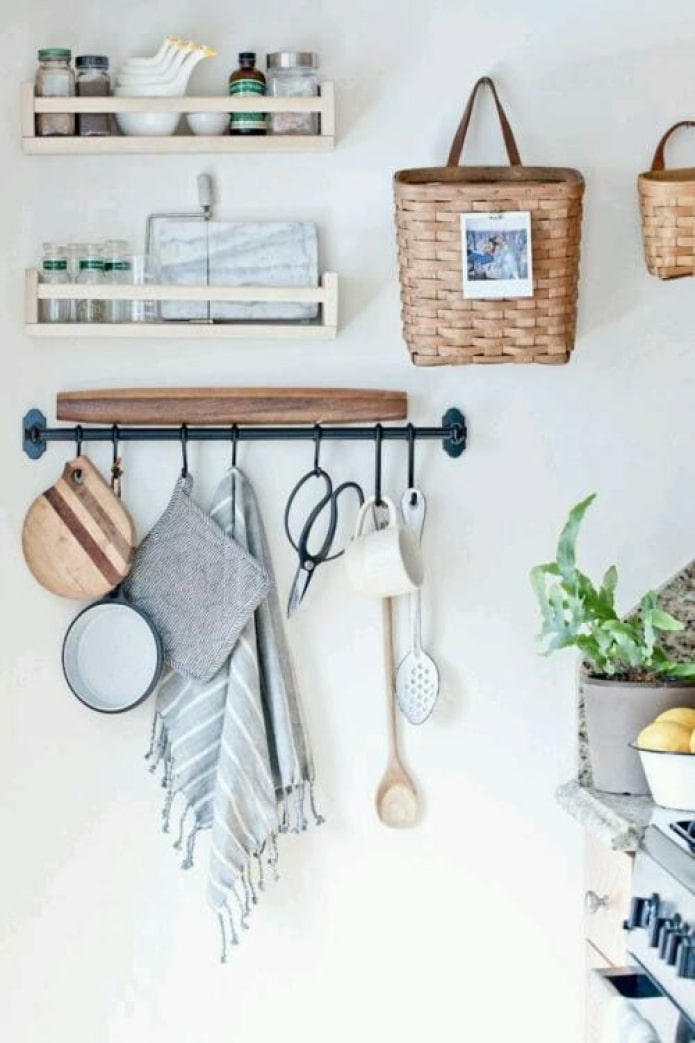
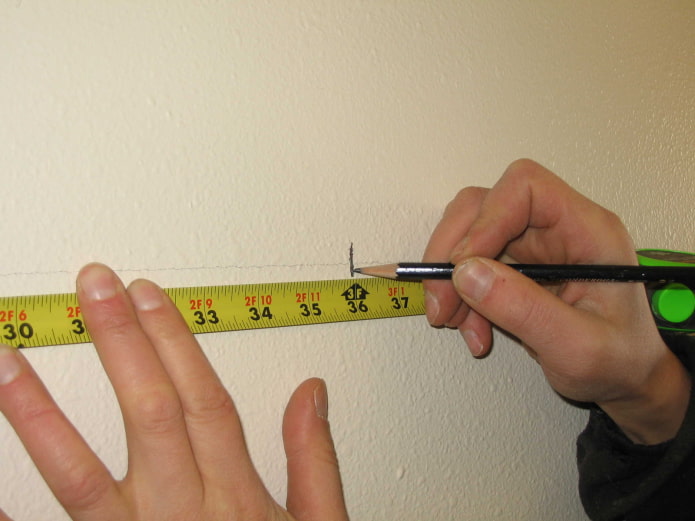

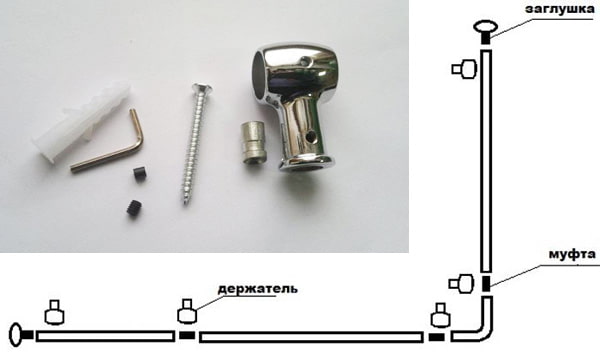
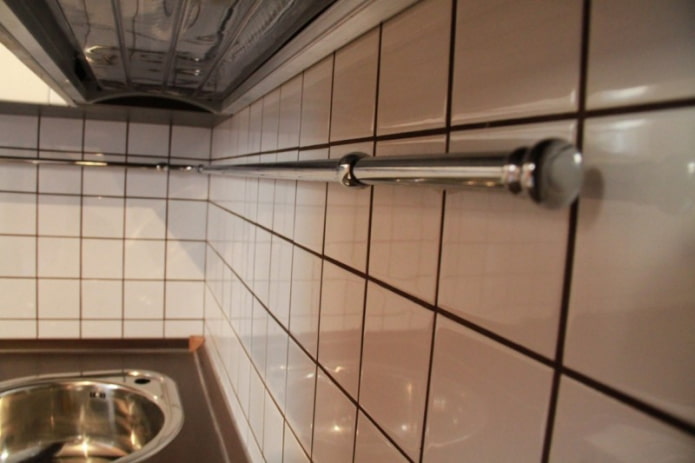



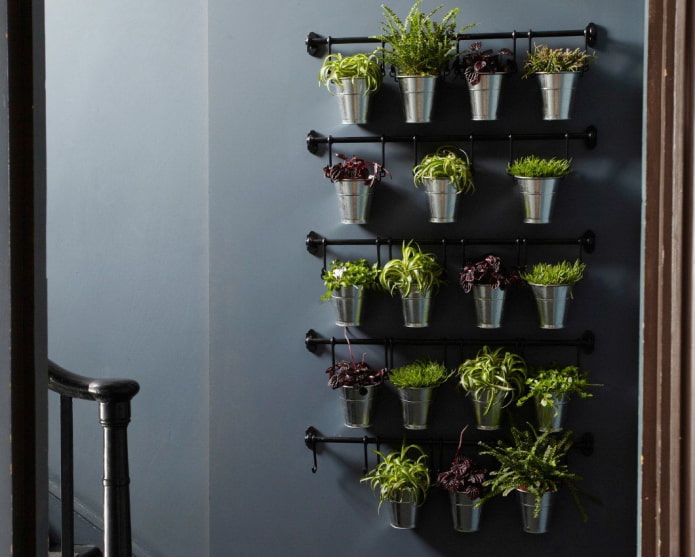
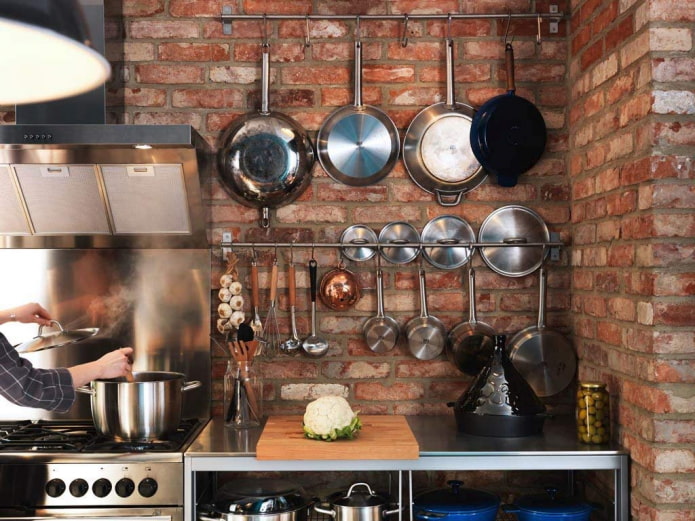
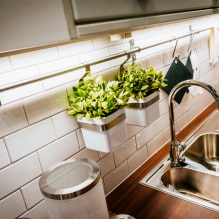

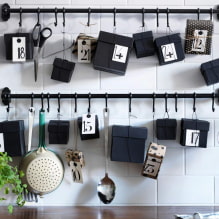
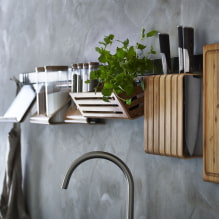
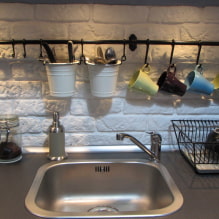
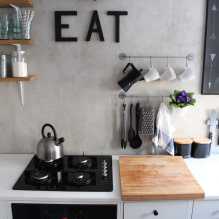
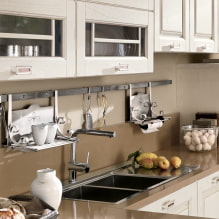

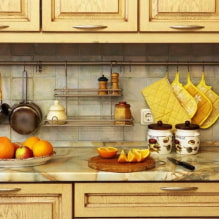

 How to choose the color of the sink for the kitchen?
How to choose the color of the sink for the kitchen? White kitchen: features of choice, combination, 70 photos in the interior
White kitchen: features of choice, combination, 70 photos in the interior Black suite in the interior of the kitchen: design, choice of wallpaper, 90 photos
Black suite in the interior of the kitchen: design, choice of wallpaper, 90 photos Modern design ideas for curtains for the kitchen - we make out the window stylish and practical
Modern design ideas for curtains for the kitchen - we make out the window stylish and practical Wallpaper design: 65 photos and ideas for a modern interior
Wallpaper design: 65 photos and ideas for a modern interior Design of a white kitchen with a black countertop: 80 best ideas, photos in the interior
Design of a white kitchen with a black countertop: 80 best ideas, photos in the interior